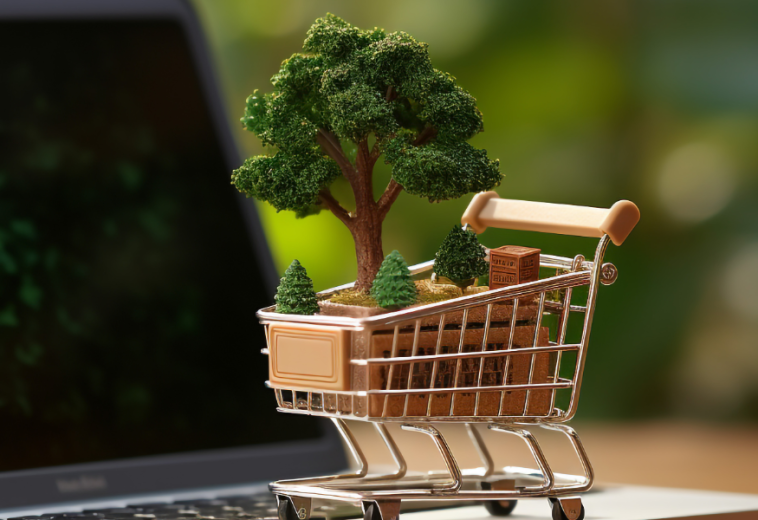Building Sustainable E-commerce: Eco-Friendly Practices and Technologies
The e-commerce landscape has exploded in recent years, overcoming hurdles to become a dominant force. While physical stores were once the undisputed shopping destination, consumer preferences have shifted dramatically. The rise of accessible online platforms has empowered environmentally conscious consumers to find and support businesses practicing Green E-commerce.
Gone are the days of overflowing delivery boxes and mountains of plastic bags. There’s a new way to shop online that’s good for you, good for business, and good for the planet: Green E-commerce!
This innovative approach takes sustainability to the heart of online shopping. It Involves everything from sourcing eco-friendly materials to implementing eco-conscious practices in packaging and delivery.
Why Eco-Friendly Shopping is Booming: The Rise of Sustainability in E-commerce
Sustainability is no longer a niche concern in e-commerce, it’s becoming a crucial factor for several reasons:
- Eco-Conscious Consumers: People are increasingly aware of the environmental impact of their choices, including online shopping. The convenience of e-commerce comes with a hidden cost: increased carbon emissions, energy use, and mountains of packaging waste.
- Demand for Change: As this awareness grows, consumers are demanding more sustainable practices from e-commerce businesses. They’re looking for companies that prioritize eco-friendly packaging, minimize shipping footprints, and operate with energy efficiency.
- A New Generation of Shoppers: Younger generations, like Gen Z, are particularly passionate about environmental issues. They actively seek out brands that align with their values and are willing to support businesses committed to sustainability.
- Competitive Advantage: By embracing sustainability, e-commerce businesses can gain a competitive edge. Eco-conscious shoppers are more likely to choose brands that demonstrate a commitment to the environment.
In short, consumers are driving the change. They’re demanding eco-friendly options, and businesses are responding by integrating sustainability into their e-commerce strategies..
Go Green and Grow Your Ecommerce Business

Here are some easy ways to make your online store more sustainable:
- Eco-Friendly Packaging:
- Use the right size boxes to avoid wasted space.
- Choose recyclable packaging materials like cardboard.
- Explore eco-friendly alternatives like paper cushioning.
- Reduce Returns:
- Provide clear product descriptions and sizing information.
- Offer high-quality photos from multiple angles.
- Consider offering 360° product views.
- Sustainable Shipping:
- Partner with carriers offering eco-friendly options.
- Offer slower, more fuel-efficient shipping methods.
- Encourage customers to choose in-store pickup (if applicable).
- Be Energy Smart:
- Turn off lights and equipment when not in use.
- Invest in energy-efficient appliances and lighting.
- Consider switching to renewable energy sources (if possible).
- Embrace Sustainability:
- Sell eco-friendly products whenever possible.
- Offer customers a carbon offset option at checkout.
- Partner with resale marketplaces for used merchandise (relevant to your industry).
By taking these steps, you can make your online store more sustainable and appeal to eco-conscious customers. Remember, even small changes can make a big difference!
Build a Greener Shopping Experience!

Sustainability is a growing concern for online shoppers, and developers play a crucial role in making e-commerce more eco-friendly. Here are some ways developers can integrate sustainable practices into the buying experience:
- Optimize Product Pages and Search:
- Accurate Descriptions & High-Quality Images: Reduce returns by providing detailed product descriptions, size charts, and high-resolution images from multiple angles. This helps customers make informed choices, minimizing the need for returns which require additional shipping.
- Smart Filtering & Sorting: Implement filters and sorting options based on sustainability criteria (e.g., recycled materials, energy efficiency). This empowers customers to easily find eco-friendly products.
- Life Cycle Information: Consider including product life cycle information, such as durability, repairability, and end-of-life options. This allows customers to make informed choices about the long-term environmental impact of their purchases.
- Eco-Friendly Packaging Options:
- Packaging Customization: Allow customers to choose from minimal or recycled packaging options at checkout. This gives them control over the amount of packaging used.
- Clear Packaging Instructions: Provide clear instructions on how to recycle or compost packaging materials. This encourages responsible disposal and reduces waste.
- Partner with Sustainable Packaging Suppliers: Collaborate with suppliers that offer eco-friendly packaging alternatives like biodegradable materials or recycled cardboard.
- Sustainable Shipping Options:
- Carbon Offset Programs: Integrate carbon offset options at checkout. Customers can choose to offset the emissions from their purchase by contributing to programs that plant trees or invest in renewable energy.
- Localized Warehousing: Explore the possibility of using localized fulfillment centers to reduce shipping distances and emissions.
- Transparent Shipping Information: Display estimated carbon emissions associated with different shipping options. This empowers customers to make conscious choices about their delivery methods.
- Building Transparency and Trust:
- Sustainability Badges and Certifications: Integrate badges or logos that showcase your green certifications or sustainable practices. This builds trust with eco-conscious customers.
- Sustainability Section: Create a dedicated page outlining your company’s sustainability initiatives and commitments. This fosters transparency and allows customers to learn more about your eco-friendly efforts.
- Progress Tracking and Reporting: Consider publishing regular reports on your sustainability progress, highlighting metrics like waste reduction or renewable energy usage. This demonstrates your commitment and allows customers to see the impact.
By implementing these practices, developers can help create a more eco-friendly e-commerce experience for everyone. Remember, small changes can add up to a big difference!
IKEA’s Green Side: Sustainable Shopping You Can Trust
Here’s why you can feel good about shopping at IKEA:
- Renewable Energy: They’re committed to using 100% renewable energy sources in their operations.
- Sustainable Materials: Over 60% of their products are already made with renewable materials, and they’re aiming for 100% renewable or recyclable materials by 2030.
- Protecting Forests: IKEA uses mostly FSC-certified or recycled wood, and they’re working to ensure all their raw materials (like soy, palm oil, and coffee) are deforestation-free by 2025.
- Smart Inventory Management: Using AI, they can predict demand with near perfect accuracy, helping to reduce waste from excess stock.
Estée Lauder: Pioneering Sustainability in Cosmetics
Estée Lauder, a name synonymous with beauty, is also a leader in sustainable practices. Founded decades ago, they’ve been at the forefront of eco-friendly makeup manufacturing since the early 2000s. Here’s how they’re making a difference:
- Waste-Free Manufacturing: Their facilities in North America and Europe achieve near-zero waste by sending anything unusable for recycling or reuse to energy-generating incinerators.
- Ambitious Goals: Estée Lauder is committed to a greener future. They aim for an all-electric vehicle fleet by 2030 and at least 75% sustainable packaging by 2025 (including refillable, recyclable, and recoverable options). They’re already at 59% and climbing!
- Carbon Offsetting: They contribute to forest management programs to compensate for emissions generated by some deliveries.
FAQs: Building Sustainable E-commerce
Why is sustainability becoming important in e-commerce?
Consumers are increasingly aware of the environmental impact of online shopping, including packaging waste, carbon emissions, and energy use. They’re demanding more sustainable practices from e-commerce businesses.
What are the benefits of going green in e-commerce?
- Attract eco-conscious customers
- Gain a competitive edge
- Potentially save money on shipping
- Help the planet
How can businesses make their e-commerce operations more sustainable?
- Packaging: Use eco-friendly materials like compostable plastics, recycled paper, and the right-sized boxes.
- Shipping: Offer carbon-neutral shipping options, locate warehouses closer to customers, and use transparent shipping information.
- Energy Efficiency: Power operations with renewable energy sources and use energy-saving technology.
- Transparency and Trust: Get green certifications, create a sustainability section on your website, and track your progress.
How can developers contribute to a greener shopping experience?
- Optimize product pages: Provide detailed descriptions, high-quality images, and life cycle information to reduce returns.
- Enable eco-friendly options: Offer minimal/recycled packaging at checkout and partner with sustainable packaging suppliers.
- Promote sustainable shipping: Integrate carbon offset programs, explore localized warehousing, and display transparent shipping information.
- Build trust: Showcase green certifications and create a sustainability section on the website.
What are some ways to empower customers to make eco-friendly choices?
- Provide filters and sorting options based on sustainability criteria.
- Offer clear instructions on how to recycle or compost packaging.
- Educate customers about the environmental impact of different shipping options.
By working together, businesses and developers can create a more sustainable e-commerce experience for everyone. Remember, even small changes can make a big difference!
Going Green Pays Off: A Sustainable Future for E-commerce
The e-commerce boom is going green! Eco-conscious consumers are driving the demand for sustainable practices. By adopting eco-friendly packaging, shipping, and operations, businesses can attract new customers, gain a competitive edge, and help the planet. Developers can play a key role by optimizing buying experiences and promoting sustainable options. Together, small changes can make a big difference. Let’s build a greener e-commerce future!
As an award-winning agency, Codx takes pride not just in the digital solutions we offer our partners but also in our advisory expertise.
We are here to help you create the perfect plan for your exciting new business venture. Whether you are just starting out or considering the idea, we’ve got you covered.
Contact us today and let’s discuss how we can develop a Sustainable Ecommerce strategy to position your brand for success in the e-commerce revolution!
Book your free consultation now.
- 32 views
- 0 Comment



